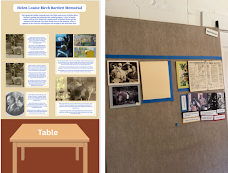 |
| Frederick's Studio |
Hello Reader,
This week at the Bonnet House Museum and Gardens, I continued my work on the Helen Birch Bartlett Memorial Exhibit and also had the opportunity to take on some unexpected and fascinating collections work. It was a week of both planning and hands-on tasks that gave me a deeper appreciation for the responsibilities involved in museum work.
Wednesday: Exhibit Planning
 |
| Planning the layout |
Since I had finished writing the signage text and pulling archival materials last week, my goal this week was to move forward with the physical setup of the Helen exhibit. Katie and I began by looking through the boards that had been used in previous exhibits. We decided on a 7-foot-tall tan fabric board that had previously served as a room partition in the studio.
Using the signage text I had written, I decided on the corresponding photographs and began mapping out how everything would be arranged on the board. I used Canva to create a digital mockup, organizing the text boxes and images in a way that was visually pleasing and easy to follow. After taking measurements of the board, I finalized the layout and sent the completed files (photos and text) to Katie for printing. We also picked out cardstock and foam board for mounting the signs and placed an order on Amazon. That wrapped up the Helen exhibit work for the week.
Thursday: Deaccessioning the Trunk
 |
Artifacts from the trunk
|
On Thursday, we shifted gears. When I arrived at the museum, Katie asked me to meet her in Frederick’s art studio. Katie had found a trunk full of artifacts (plaster flowers, wooden cherubs, clay statues, glass bottles, and more) that had been stored away and loosely cataloged about twenty years ago. After reviewing the contents, Katie and the CEO of Bonnet House determined that only two of the sculptures would be kept; the rest were to be deaccessioned.
 |
The cherub and Chinese dog I brought home
(dog's current and previous condition). |
Because none of the remaining items had clear significance, historical context, or market value, they could not be sold or donated to other institutions. Unfortunately, the only remaining option was disposal. My task was to remove accession numbers from any labeled items, confirm their status in the records (marking them as D/A if I could find them), and place them in trash bags for disposal. Although museum policy doesn’t allow staff to “take” artifacts, the bag was placed
next to the dumpster rather than
inside it. I was lucky enough to take home a wooden cherub candle holder and a broken clay Chinese foo dog. I’m going to try to restore both at home.
Restoration Work
 |
| Repainting the broken frame |
After completing the deaccessioning task, I spent the remainder of the day helping restore a wooden frame fragment from one of Frederick’s paintings, a recreation of
Napoleon Crossing the Alps by Jacques-Louis David. The frame had been damaged while it was being hung up, but Katie had already repaired the structure and filled in the missing sections with plaster. My job was to color-match and apply acrylic paint to complete the restoration work. It came out pretty fabulous, if I do say so myself.
The Rooster (Still Elusive)
Unfortunately, the promising lead I had on the mysterious metal rooster turned out to be a false alarm. The rooster I found in the archival system belongs to the “Beverly Collection” (a set of artifacts from another Bartlett estate in Beverly, Massachusetts), not the Bonnet House collection. So, the rooster remains unfound… for now. I’m not giving up.
This week offered a good balance of research, exhibit planning, and hands-on conservation tasks. I’m excited to continue developing the Helen exhibit next week, and maybe, just maybe, identify that mysterious rooster.
See you soon,
Maria Formoso








Comments
Post a Comment